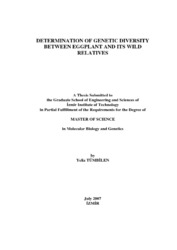Please use this identifier to cite or link to this item:
https://hdl.handle.net/11147/3069Full metadata record
| DC Field | Value | Language |
|---|---|---|
| dc.contributor.advisor | Doğanlar, Sami | - |
| dc.contributor.author | Tümbilen, Yeliz | - |
| dc.date.accessioned | 2014-07-22T13:50:49Z | - |
| dc.date.available | 2014-07-22T13:50:49Z | - |
| dc.date.issued | 2007 | - |
| dc.identifier.uri | http://hdl.handle.net/11147/3069 | - |
| dc.description | Thesis (Master)--Izmir Institute of Technology, Molecular Biology and Genetics, Izmir, 2007 | en_US |
| dc.description | Includes bibliographical references (leaves: 71-76) | en_US |
| dc.description | Text in English; Abstract: Turkish and English | en_US |
| dc.description | x, 76 leaves | en_US |
| dc.description.abstract | Eggplant (Solanum melongena L.) is an important crop and has a growing reputation and is now cultivated globally. It is a valuable member of the human diet in Asia, especially in India, which is a primary diversity center of the species. Turkey is the first in Europe and is in the first five countries around the world in terms of eggplant production. The Solanaceae family to which S. melongena belongs is an important family, too. Tomato, potato, tobacco and petunia are some example species of the Solanaceae family. This important family with 3000-4000 species shows a high level of morphological diversity which results in confusion about its systematics and this diversity is at the level of genera, species and cultivars. The aims of the studies reported in this thesis were to analyze genetic diversity of Turkish eggplants and wild relatives in separate studies with different molecular tools. To reveal genetic diversity among eggplant cultivars grown in Turkey, the AFLP marker system was applied to the sample genotypes. For the investigation of genetic variation between S. melongena and its wild relatives, though, the SSR marker system was used. For the AFLP data for Turkish eggplants, an r value of 0.97 was obtained which was in the best scale. Eigen values reported here were also informative. These results showed that the first component analysis explained 64.34% of the variation between samples. For three axes, though, a total of 72.21% variation was explained. According to the statistical results of SSR analysis, the r value of Solanum species. genotypic data was found to be 0.88. That means the correlation between sample genotypic data and dendrogram was found to be high. Due to the other statistical results which were Eigen values explained 46.12% of genotypes for first component analysis. With a total value of 55.28%, the 47 different genotypes were explained by the three principle component axes. The results of AFLP studies showed that although a high similarity value was observed, diversity was detectable among the accessions. The results of SSR studies were also meaningful with their concordance with previous studies and observed diversity with a good fit to statistical results. | en_US |
| dc.language.iso | en | en_US |
| dc.publisher | Izmir Institute of Technology | en_US |
| dc.rights | info:eu-repo/semantics/openAccess | en_US |
| dc.subject.lcc | QK981.5 T92 2007 | en |
| dc.subject.lcsh | Plant genetic engineering | en |
| dc.subject.lcsh | Plant genome mapping | en |
| dc.subject.lcsh | Eggplant--Varieties | en |
| dc.title | Determination of Genetic Diversity Between Eggplant and Its Wild Relatives | en_US |
| dc.type | Master Thesis | en_US |
| dc.institutionauthor | Tümbilen, Yeliz | - |
| dc.department | Thesis (Master)--İzmir Institute of Technology, Molecular Biology and Genetics | en_US |
| dc.relation.publicationcategory | Tez | en_US |
| dc.identifier.wosquality | N/A | - |
| dc.identifier.scopusquality | N/A | - |
| item.openairecristype | http://purl.org/coar/resource_type/c_18cf | - |
| item.openairetype | Master Thesis | - |
| item.languageiso639-1 | en | - |
| item.grantfulltext | open | - |
| item.fulltext | With Fulltext | - |
| item.cerifentitytype | Publications | - |
| Appears in Collections: | Master Degree / Yüksek Lisans Tezleri | |
Files in This Item:
| File | Description | Size | Format | |
|---|---|---|---|---|
| T000639.pdf | MasterThesis | 988.67 kB | Adobe PDF |  View/Open |
CORE Recommender
Page view(s)
272
checked on Jun 16, 2025
Download(s)
126
checked on Jun 16, 2025
Google ScholarTM
Check
Items in GCRIS Repository are protected by copyright, with all rights reserved, unless otherwise indicated.